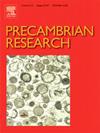Detrital zircon record of shutdown and migration of Cadomian volcanic arcs in the Bohemian Massif, with implications for Ediacaran to early Cambrian plate kinematics
IF 3.2
2区 地球科学
Q2 GEOSCIENCES, MULTIDISCIPLINARY
引用次数: 0
Abstract
This paper presents new U–Pb detrital zircon ages that constrain the age of deposition of a Cadomian intra-arc succession (Štěchovice Group in the Bohemian Massif) overlying one of the best preserved volcanic arcs (Davle volcanic complex) of the Avalonian–Cadomian belt, which rimmed the northern margin of Gondwana in the Neoproterozoic to Cambrian. The record of this active margin is well preserved, but how subduction terminated along it remains a matter of debate. Our new data from the Štěchovice Group suggest abrupt arc termination in this region followed by turbidite deposition in a short-lived basin at around 570 Ma. However, the ages of voluminous arc-derived graywackes in a neighbouring accretionary wedge suggest arc magmatism continued until ca. 527 Ma. Regional gravity highs inboard of the Davle volcanic arc indicate the presence of unexposed dense rocks that may represent the missing, post-570 Ma Cadomian arc. If so, the arc axis migrated landward, consistent with the presence of intrusive boninites within the older Davle arc, which would have then occupied a fore-arc position and must have been eroded and submerged prior to the deposition of Štěchovice Group. We suggest that the inferred arc migration beginning at around 570 Ma occurred in response to slab flattening due to the arrival of hotter oceanic lithosphere, perhaps in the form of a spreading ridge that migrated eastwards along the Avalonian–Cadomian active margin leaving a dextral transform margin in its wake. Such a ridge is thought to have first impinged on Avalonia to the west at around 600 Ma and later caused arc extinction in the Armorican Massif and Saxothuringian unit at around 570 Ma, with arc migration in the Bohemian Massif at about the same time. The ridge–trench interaction is then inferred for the Bohemian Massif in the early to middle Cambrian (at ca. 527–515 Ma), consistent with ongoing subduction in the more easterly proto-Alps until the mid-Ordovician. How the inferred migration of the ridge–trench–transform system was linked to the movement of Baltica, and whether it could have brought Baltica close enough to supply Mesoproterozoic detritus to Gondwana’s northern periphery remain open questions.

波西米亚地块卡多米亚火山弧关闭和迁移的碎屑锆石记录及其对埃迪卡拉纪至早寒武世板块运动的启示
本文提出了新的U-Pb碎屑锆石年龄,这些锆石年龄限制了位于新元古代至寒武纪冈瓦纳北缘阿瓦洛尼亚-卡多米尼亚火山带保存最完好的火山弧之一(Davle火山杂岩)上的卡多米尼亚弧内序列(波希米亚地块Štěchovice群)的沉积时代。这个活动边缘的记录保存得很好,但是俯冲作用是如何沿着它结束的,这仍然是一个有争议的问题。我们来自Štěchovice组的新数据表明,该地区的弧突然终止,随后在570 Ma左右的短暂盆地中发生浊积沉积。然而,在邻近的一个增生楔中,大量的弧源灰岩的年龄表明,弧岩浆活动一直持续到约527 Ma。Davle火山弧内部的区域重力高表明存在未暴露的致密岩石,这些岩石可能代表570 Ma后的卡多米亚弧。如果是这样,那么弧轴向陆地移动,这与在更古老的达维尔弧内存在侵入性博长岩相一致,后者可能占据弧前位置,并且一定在Štěchovice群沉积之前被侵蚀和淹没。我们认为,从570 Ma左右开始的弧迁移是对热洋岩石圈到来导致的板块变平的响应,可能是沿阿瓦洛尼亚-卡多米尼亚活动边缘向东移动的扩张脊的形式,在其尾迹中留下了一个右向转换边缘。这样的一个脊被认为在大约600 Ma的时候首先撞击了阿瓦洛尼亚西部,后来在大约570 Ma的时候造成了阿莫里亚地块和萨克森图林根单元的弧灭,同时在波西米亚地块发生了弧迁移。据此推断波西米亚地块在早至中寒武纪(约527-515 Ma)存在脊沟相互作用,这与更偏东的原阿尔卑斯山脉直到中奥陶纪的持续俯冲相一致。山脊-海沟-转换系统的迁移是如何与波罗的海的运动联系起来的,以及它是否能把波罗的海带到足够近的地方,为冈瓦纳的北部边缘提供中元古代的碎屑,这些问题仍然悬而未决。
本文章由计算机程序翻译,如有差异,请以英文原文为准。
求助全文
约1分钟内获得全文
求助全文
来源期刊

Precambrian Research
地学-地球科学综合
CiteScore
7.20
自引率
28.90%
发文量
325
审稿时长
12 months
期刊介绍:
Precambrian Research publishes studies on all aspects of the early stages of the composition, structure and evolution of the Earth and its planetary neighbours. With a focus on process-oriented and comparative studies, it covers, but is not restricted to, subjects such as:
(1) Chemical, biological, biochemical and cosmochemical evolution; the origin of life; the evolution of the oceans and atmosphere; the early fossil record; palaeobiology;
(2) Geochronology and isotope and elemental geochemistry;
(3) Precambrian mineral deposits;
(4) Geophysical aspects of the early Earth and Precambrian terrains;
(5) Nature, formation and evolution of the Precambrian lithosphere and mantle including magmatic, depositional, metamorphic and tectonic processes.
In addition, the editors particularly welcome integrated process-oriented studies that involve a combination of the above fields and comparative studies that demonstrate the effect of Precambrian evolution on Phanerozoic earth system processes.
Regional and localised studies of Precambrian phenomena are considered appropriate only when the detail and quality allow illustration of a wider process, or when significant gaps in basic knowledge of a particular area can be filled.
 求助内容:
求助内容: 应助结果提醒方式:
应助结果提醒方式:


